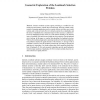Free Online Productivity Tools
i2Speak
i2Symbol
i2OCR
iTex2Img
iWeb2Print
iWeb2Shot
i2Type
iPdf2Split
iPdf2Merge
i2Bopomofo
i2Arabic
i2Style
i2Image
i2PDF
iLatex2Rtf
Sci2ools
PAM
2004
Springer
2004
Springer
Geometric Exploration of the Landmark Selection Problem
Abstract. Internet coordinate systems appear promising as a method for estimating network distance without direct measurement, allowing scalable configuration of emerging applications such as content delivery networks, peer to peer systems, and overlay networks. However all such systems rely on landmarks, and the choice of landmarks has a dramatic impact on their accuracy. Landmark selection is challenging because of the size of the Internet (leading to an immense space of candidate sets) and because insight into the properties of good landmark sets is lacking. In this paper we explore fast algorithms for landmark selection. Whereas the traditional approach to analyzing similar network-based configurkation problems employs the graph structure of the Internet, we leverage work in coordinate systems to treat the problem geometrically, providing an opening for applying new algorithms. Our results suggest that when employing small numbers of landmarks (5-10), such geometric algorithms pr...
Computer Networks | Coordinate Systems | Internet Coordinate Systems | Landmark Selection | PAM 2004 |
| Added | 02 Jul 2010 |
| Updated | 02 Jul 2010 |
| Type | Conference |
| Year | 2004 |
| Where | PAM |
| Authors | Liying Tang, Mark Crovella |
Comments (0)

